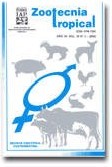
|
Zootecnia Tropical
Instituto Nacional de Investigaciones Agrícolas Venezuela
ISSN: 0798-7269
Vol. 23, No. 2, 2005, pp. 121-139
|
 Bioline Code: zt05010
Bioline Code: zt05010
Full paper language: English
Document type: Research Article
Document available free of charge
|
|
|
Zootecnia Tropical, Vol. 23, No. 2, 2005, pp. 121-139
| en |
Botanical identification and fruit production in a deciduous forest at Las Peñitas settlement, south of Aragua state, Venezuela
José Valero, Miguel Benezra, Selina Camacaro, Luís Chong y Orlando Guenni
Abstract
Herbarium specimen were collected in order to identify the woody species present in a deciduous forest, as well as their frequency, density and the degree of diversity of the forest. The studied forest was divided in four different areas: no intervened forest, forest no recently intervened, forest partially intervened recently, and forest completely intervened recently, and in each area 3 experimental plots of 100 m x 5 m were set along topography gradients. The frequency and density were determined by the number of individuals of each species in the plot, and the degree of diversity was assumed by the Simpson and Shannon's indexes. There were 32 different botanical species, predominating the Leguminoseae family with 37% and 14 other families that represented 63%. Differences were found in the quantity and frequency of the species among the physiognomic areas, as well as differences among species in the same area. The area with higher species density was the no intervened forest (2780 plants/ha). The degree of diversity evaluated by the Simpson and Shannon's indexes was higher (P<0.05) for the not intervened forest (15.1 and 4.01, respectively). Although all these communities have the potential for animal feeding, the no intervened forest seems to have the best potential for this purpose because of better botanical indicators.
Keywords
deciduous forest, fruit production, botanical characterization, frequency, diversity.
|
| |
| es |
Identificación botánica y producción de frutos en un bosque deciduo del asentamiento Las Peñitas, al sur del estado Aragua, Venezuela
José Valero, Miguel Benezra, Selina Camacaro, Luís Chong y Orlando Guenni
Resumen
Se colectaron muestras vegetales con el objeto de identificar botánicamente las especies leñosas presentes en un bosque deciduo, así como su frecuencia, densidad y el grado de diversidad dentro del bosque. El bosque en estudio se dividió en cuatro áreas diferentes: bosque no intervenido, bosque no intervenido recientemente, bosque parcialmente intervenido recientemente y bosque totalmente intervenido recientemente y en cada una se establecieron 3 transectas de 100 m x 5 m. La frecuencia y densidad se determinaron por el número de individuos de cada especie presentes en cada transecta y el grado de diversidad se estimó mediante los índices de Simpson y de Shannon. Se encontraron 32 especies botánicas diferentes, predominando la familia Leguminoseae con un 37% de participación y otras 14 familias que representaron el otro 63%. Se evidenciaron diferencias en la cantidad y la frecuencia de las especies entre cada una de las áreas fisonómicas, así como diferencias entre especies en la misma área. El área con mayor densidad de especies fue el bosque no intervenido (2.780 plantas/ha). El grado de diversidad evaluado por los índices de Simpson y de Shannon resultó mayor (P<0,05) para el bosque no intervenido (15,1 y 4,01, respectivamente). Así, aunque todas estas comunidades tienen potencial para la alimentación animal, el bosque no intervenido parece tener el mayor potencial para la alimentación de rumiantes, por presentar mejores indicadores botánicos.
Palabras-clave
bosque deciduo, producción de frutos, caracterización botánica, frecuencia, diversidad.
|
| |
© Copyright 2005 - Zootecnia Tropical
Alternative site location: http://www.sian.inia.gob.ve/repositorio/revistas_ci/ZootecniaTropical/ztindice.htm
|
|
